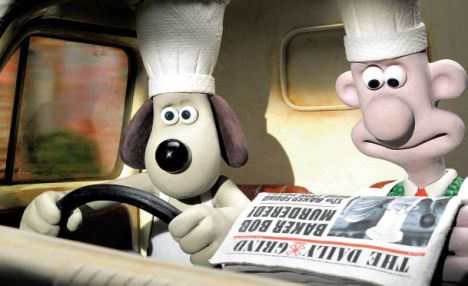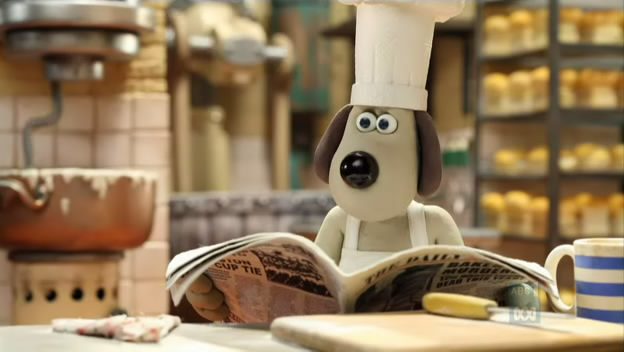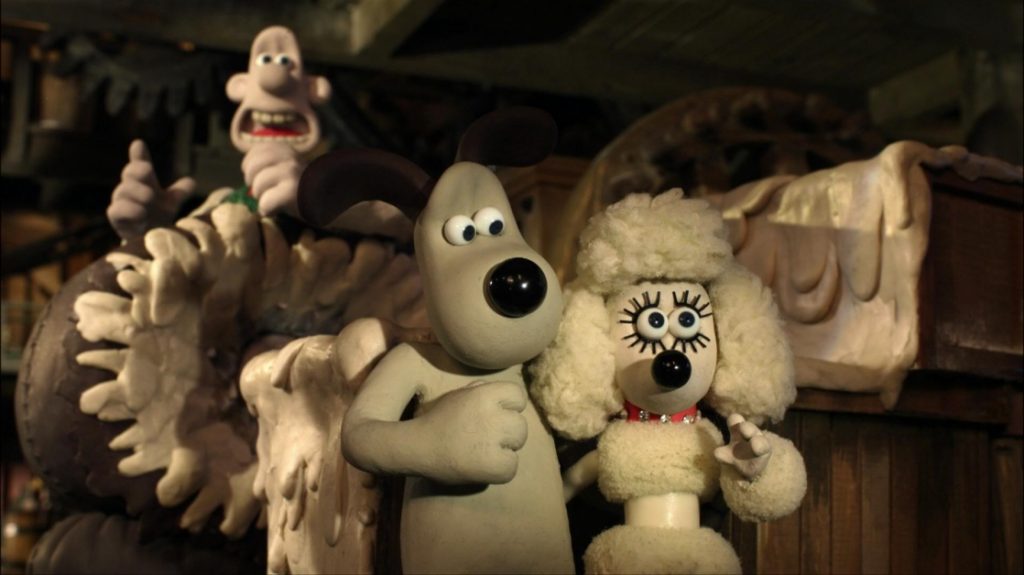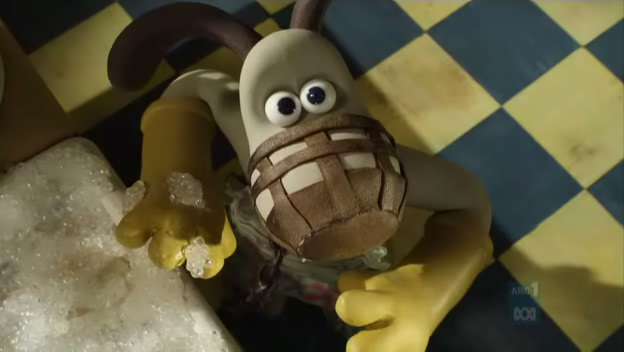Beloved characters Wallace and his side-kick canine Gromit return for another film, and this time they are running Top Bun, a brand new bakery. Business is booming for the duo, but a serial killer is on the loose, killing all the bakers in town. While Gromit begins to fear for the pair’s safety, Wallace is distracted, having fallen head-over-heels for Piella Bakewell, former star of the Bake-o-Lite bread commercials. Everything appears to be going swimmingly for Wallace and his doughy new love-interest, until Gromit uncovers a shocking secret that may reveal the identity of the serial killer. With their whole lives suddenly thrown into question, Gromit must pull out all the stops to save Wallace in an enthralling race against the clock. In tradition of ‘master of suspense’ Alfred Hitchcock, four-time Academy Award-winning director Nick Park creates a hilariously brilliant and nail-biting new masterpiece.
A Matter of Loaf and Death (2008)can be enjoyed by younger or older viewers; it is primarily a family-comedy. Absurd moments of slapstick comedy, such as Wallace’s trousers being loaded with pastry, will appeal to children. However, the jokes range in subtlety and accessibility, with some catering more directly for adults. For example, Wallace’s innocent claim of being “in bread” is an entertaining gag for older viewers, made more amusing by Gromit’s mortified expression. Gromit’s expressive eye rolls and pantomime gestures provide much of the film’s comedy as they often serve to highlight his stoic intelligence against Wallace’s slowness. The short is, for want of a better phrase, ‘quintessentially British’. Rather, the sign reading ‘Yorkshire Border – Keep Out!’ and the richly detailed scenery depicting a homely Lancashire town make the film quintessentially Northern. Commenting on its intended British audience, Nick Park said: ‘I don’t feel like I’m making a film for a kid in some suburb of America – and being told they’re not going to understand a joke, or a northern saying.’ [1] Despite this, the original title of Trouble at Mill was considered too obscure a Northern England colloquialism and was subsequently changed to have a broader appeal. The film falls, secondarily, under the genre of a thriller. The opening scene sees Baker Bob get murdered, yet the charming appeal of stop-motion allows the film to maintain a consistently light-hearted balance between crime and comedy. Humorous moments arise from visual gags which often play with the character of Gromit and his curious mix of human and animal qualities; his possession of a magazine entitled ‘The Beagle’ alludes to the famous British comic ‘The Eagle’, while the ‘Citizen Canine’ poster is an allusion to Orson Welles’ ‘Citizen Kane’ (1941). Not only do these subtle references cater for older audiences, they also make use of the simple but effective comedy generated by a mute but literate dog.
Primarily, Gromit is presented as highly intelligent. Although he is only a pet, Gromit’s anthropomorphisation allows him to be depicted as quick-witted and able to understand language. The opening shot sees him reading about the series of local murders in a newspaper, and then gulping, which immediately sets up a suggestion of the events to come. In the following minutes we see him single-handedly operating the bustling bakery and multi-tasking while Wallace is still in bed. A significant part of the film’s comical element is added by Gromit’s social intelligence and ability to make sense of his human surroundings; for example, the expression on his face when Wallace makes his ‘in bread’ comment shows he has immediately understood the irony and is visibly embarrassed on behalf of his owner, which is an amusing moment for the viewer. Because he lacks the vital humanistic trait of speech, Gromit’s inner thoughts are mostly communicated via his expressive eyes and eyebrows, which lend him a distinctly loveable, cartoon-ish appeal. The emphasis placed on his evocative and revealing facial movements means we are highly attuned to his thoughts and feelings without ever needing verbalisation. Interestingly, Nick Park attributes his expressiveness to being a clay figure; with clay, ‘you can create character out of tiny nuances’. [2] For example, when Paella moves her belongings into their home, Gromit’s initial outrage and mounting suspicion are obvious from his range of expressions; his reaction, accompanied with the dramatic orchestral music which builds in intensity suggests a sense of impending danger.
Not only is Gromit intelligent, but the film highlights his competence in vivid contrast with Wallace’s incompetence. A lot of the humour in the film is reliant on this disparity between an exceptionally smart, proficient dog and his completely inept human companion; to reverse roles this way provides much scope for comical moments. Despite being more competent than Wallace, the fact Gromit is unable to speak allows him to be a sympathetic character, because he cannot demonstrate his intelligence through verbalisation. Hence, the film’s dilemma is established when he cannot simply tell the oblivious Wallace that Paella is the murderer, but has to work extremely hard to protect him from danger. Dogs are typically considered ‘cute’, domestic pets, so the human-animal role reversal which sees Gromit act as the guardian of Wallace is comical because it is so far removed from reality. This sense of Gromit assuming a kind of parental role is present throughout the film, and he is visibly displeased with Wallace and Paella’s new relationship, sensing something suspicious about her. When Paella turns up to take Wallace out for the day, Gromit is seen rolling his eyes and sighing, with his paw emphatically placed on his side, like a human would place a hand on their hip. Here, he acts as the passively disapproving guardian while Wallace, despite being old, is acting like a naïve and smitten teenager. Because Wallace is blind to Paella’s true nature, Gromit is forced on a mission to save the day. We see him, in glasses, studying and writing notes from a book titled ‘Electronic Surveillance for Dogs’, which guides him to create a complex security system in the house overnight. Again, for a dog to be so studious and capable is highly amusing in its sheer absurdity. The artistic license employed that makes such preposterous events seem perfectly acceptable is part of the film’s quirky, loveable appeal.
Despite all of his intelligence, Gromit is still viewed and treated as a fairly ordinary pet by Wallace. Interestingly, Gromit treads the line somewhere between a parental role and a subservient house pet; either way, Wallace would not survive for long without him. His duties range from the mundane day-to-day such as operating the bakery and serving Wallace cups of tea, to eventually having to protect him from a dangerous murderer. When Paella viciously bites her own arm and blames it on Gromit, he is chained up, muzzled and forced to wash the dishes. This punishment strikes us as ironic because he willingly does most of the domestic chores around the house anyway. However, our sympathies align with Gromit for not being able to articulate his thoughts to Wallace, and for being unfairly punished. In one scene, Wallace does not want to venture out in the rain and so asks Gromit to return Paella’s purse to her. Gromit breaks the fourth wall by looking directly into the camera with a face of reluctance, which establishes a connection with the viewer in which empathy is elicited from us. In a sense, Gromit is the central consciousness of the film because we are attuned to everything he is thinking, and because we are given access to the same knowledge he has about Paella. Absent-minded Wallace, on the other hand, is completely oblivious to what is going on. The fictional animation genre allows for the animal protagonist, a hero made even more unique by the fact he is completely mute. Once at Paella’s, Gromit assumes an investigative role and uncovers the shocking discovery that Paella is the killer. Ominous, creeping orchestral music follows him as he tiptoes upstairs. Sudden flashes of lightning and thunder seep into Paella’s dimly lit bedroom, adding to the nail-biting atmosphere and eventual horror when Gromit discovers the book of murder victims.
A Matter of Loaf and Death adheres to the stereotype of dog being a man’s best friend, with unwavering loyalty being one of Gromit’s most endearing characteristics. Wallace is not particularly bright and Gromit seems acutely aware of this fact, but still goes to great lengths to protect his loveable companion from danger. When Wallace is upset about Paella storming out, Gromit listens sympathetically and comforts him with a cup of tea. Wallace earnestly asks ‘I’m not a fruitcake, am I, lad?’, to which Gromit squints his eyes uncomfortably; unsure how to respond and reluctant to disagree, he gives him a reassuring pat on the back instead. Even Fluffles, the nervous poodle, remains somewhat loyal to Paella to an extent. That is, until, she is forced to bite Paella to escape harm. Fluffles knows Paella is evil, and meeting Gromit is the perfect opportunity to eventually collude together and defeat her. The film’s canines present the rhetoric that dogs are inherently ‘good’ and, faced with a moral dilemma, will choose the side of morality. To add to this, the film can be seen to challenge gender roles typically associated with humans, but through the characters of Gromit and Fluffles. Throughout the film, she is a nervous, shaky poodle, depicted as a kind of damsel in distress that we assume Gromit will have to heroically save. However, once freed from her oppressive life as Paella’s sidekick, Fluffles gains a new confidence. The film completely challenges our perception of the meek, giggly poodle as we suddenly see her ruthlessly and skilfully operating vehicle machinery in a final bid to defeat Paella; with a little prompting, Fluffles becomes her own hero. As it turns out, the female dog is every bit as impressive and competent as the male dog, which is an uplifting message for the film makers to promote.
Gromit being mute allows for a brilliant dynamic between him and Wallace; his expressions in response to Wallace’s various mishaps are satisfyingly comic enough to eradicate the need for dialogue between the two. In an interview with Alex Belfield, Nick Park remarked that, originally, Gromit ‘was actually going to have a mouth, and was going to do a lot of barking’ [3]. However, he discovered that ‘just by moving his eyebrows up and down, he could speak volumes’. It was this vital discovery that developed Gromit’s endearing characteristics as ‘the introvert, the clever one’, allowing for the contrast between him and Wallace that is centred at the heart of the film’s light-hearted, quirky appeal. Furthermore, the film’s impressive range of visual gags and references are a delight for viewers, who can repeatedly watch the film and spot new jokes. Many visual jokes are situated around Gromit; not only do they reveal his surprising intellect, but they are amusingly suggestive of a rich, separate life he leads outside of the film. He runs a business, he reads about current affairs, and he has a love life: the ‘F+G’ romantically etched into the tree at Paella’s house of course stands for Fluffles and Gromit. Additionally, while the plot is structured as a Hitchcockian thriller, the film’s humour derives from both the absurdity of Gromit’s character and the fact the story is told through the medium of stop-motion. Park pays homage to Hitchcock in various scenes; most notably, the recreation of Argobast creeping up the stairs of the Bates House in Psycho (1960). This time, it is Gromit investigating the abominable activity being carried out by Paella; in situating a ‘cute’ clay model of a Beagle at the core of the film, A Matter of Loaf and Death manages to execute a thriller-style while still maintaining total ebullience throughout.
Filmography
A Matter of Loaf and Death. Dir. Nick Park. Aardman Animations., 2008.
Citizen Kane. Dir. Orson Welles. Mercury Productions, 1941.
Psycho. Dir. Alfred Hitchcock. Paramount Pictures, 1960.
[1] “Wallace and Gromit return to TV”. BBC News. 2 October 2007. Archived from the original on 11 October 2007. [accessed 12th January 2016]
[2] Kate Abbot, ‘How we made Wallace and Gromit’, The Guardian (2014) http://www.theguardian.com/tv-and-radio/2014/mar/03/how-we-made-wallace-and-gromit [accessed 14th January 2016]
[3] Alex Belfield, Celebrity Radio. Nick Park Exclusive 40 Minute Interview. https://www.youtube.com/watch?v=VWQwNWlmpR8&t=3s [accessed 14thJanuary 2016]



